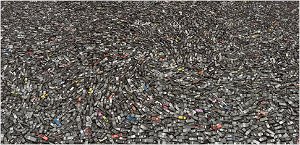Smartphones have undeniably changed our lives -- and the world -- in a very short amount of time. Just ten years ago, we took pictures with cameras, used maps to plan routes, and kept in touch with friends and family using T9 text messages.
If you're among the more than 2 billion people in the world that now uses a smartphone, chances are pretty good you remember your first smartphone. You remember how your life changed when your phone suddenly became connected to the internet and became a tool to find your way around almost anywhere instantaneously, send emails on the go, stay in touch with loved ones 24/7, and answer all your random curiosities.
But do you remember when you got your second smartphone? Or your third? Do you remember how many smartphones you've had since 2007?
We wanted to find out how many smartphones had been made since Apple's first iPhone came on to the market in 2007, and the answer surprised us -- more than 7 billion. That means that if every smartphone ever made was still operational, there would be roughly enough for every person on the planet.
Of course, this is not the case. The average phone in the United States is used for just over 2 years, despite the fact it can function for longer. Phone users are often lured into prematurely replacing their phones -- either because they are up for a new contract and the new phone appears to be "free" or because of a single failing part, such as the screen or battery, that's too complicated or expensive for the average person to repair.
At this rate, we're all on track to use at least 29 phones in our lifetimes.
This rapid turnover of devices is what leads to record profits for smartphone manufacturers year after year. It also leads to many damaging impacts on people and our planet.
Miners in remote landscapes extract tons of metal ore and precious metals for these devices. From there, these materials pass through a complex refining, processing, and manufacturing supply chain. Workers in electronics factories are often unknowingly exposed to hazardous chemicals that damage their health. These facilities our powered by an energy mix that is dominated by fossil fuels, which furthers the impacts of climate change.
In our new report "From Smart to Senseless: The Global Impact of Ten Years of Smartphones" we unpack the problems with the current smartphone production model.
Here is some of what we found:
- 7.1 billion smartphones have been produced since 2007.
- More than 60 different elements are commonly used in the manufacturing of smartphones. While the amount of each element in a single device may seem small, the combined impacts of mining and processing these precious materials for 7 billion devices is significant.
- In 2014 alone, e-waste from small IT products like smartphones was estimated to be 3 million metric tons. Less than an estimated 16 percent of global e-waste is recycled.
- Only two (Fairphone and LG G5) of 13 models reviewed had easily replaceable batteries. This means consumers are forced to replace their whole devices when the battery life starts to dwindle.
- Since 2007, roughly 968 terawatt hours (TWh) has been used to manufacture smartphones, which is nearly the same as one year's power supply for India (973 TWh in 2014)
- At end-of-life, current design makes disassembly difficult, including the use of proprietary screws and glued in batteries; therefore, smartphones are often shredded and sent for smelting when "recycled." Given the small amounts of a wide diversity of materials and substances in small devices, smelting is inefficient, or ineffective, at recovering many of the materials.
The recent recall of Samsung's overheating and explosive Galaxy Note 7 phones is a prime example of the problems with the current production model -- rushed design and production cycles can lead to costly mistakes. After investigating, the company attributed the battery flaws in part to accelerated production efforts to outpace competitors. Recalling the phones was the right choice. But now Samsung needs to decide what to do with the 4.3 million handsets.
Since November 2016, we've been calling on the company to reuse and recycle phones. To date, Samsung has not revealed its plan. Join us in calling on Samsung to recycle these phones and commit to making phones in the future that can be easily repaired, reused, and recycled.
Despite the many challenges that confront it, the IT sector is well positioned to fix these problems and set an example for all industries by moving from a linear to a circular production model -- one that reuses precious raw materials.
As IT companies have shown again and again, technology and creativity can be used as powerful forces to disrupt outdated business models. Leading IT companies can become the greatest advocates for a circular production model and a renewably powered future. The brightest designers can create toxic-free gadgets to last, be repairable, and ultimately be transformed into something new.

No comments:
Post a Comment